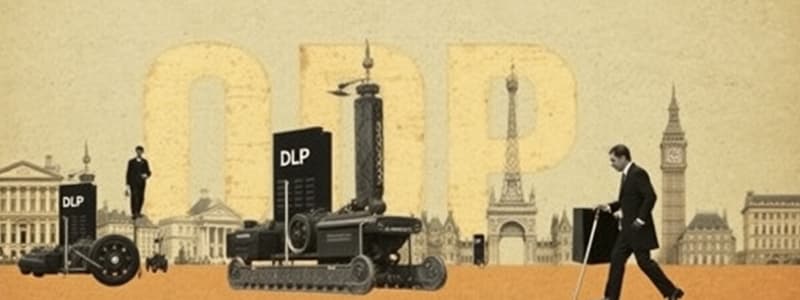Podcast
Questions and Answers
Country A can produce both wheat and cars more efficiently than Country B. However, Country A has a significantly lower opportunity cost in producing wheat compared to cars. Which trade principle should Country A focus on?
Country A can produce both wheat and cars more efficiently than Country B. However, Country A has a significantly lower opportunity cost in producing wheat compared to cars. Which trade principle should Country A focus on?
- Comparative Advantage in wheat (correct)
- Specialization in car production
- Embargoing trade with Country B
- Absolute Advantage in both goods
A country imposes a complete ban on trade with another country due to political disagreements. This action is best described as:
A country imposes a complete ban on trade with another country due to political disagreements. This action is best described as:
- A quota
- A tariff
- A subsidy
- An embargo (correct)
Which of the following is a key difference between NAFTA and the European Union (EU)?
Which of the following is a key difference between NAFTA and the European Union (EU)?
- The EU uses a common currency, while NAFTA does not. (correct)
- The EU allows completely unrestricted immigration, while NAFTA has stricter border controls.
- NAFTA involves more countries than the EU
- NAFTA focuses on political integration, while the EU focuses on trade.
If the Consumer Price Index (CPI) increases significantly over a short period, which of the following is the most likely conclusion?
If the Consumer Price Index (CPI) increases significantly over a short period, which of the following is the most likely conclusion?
A manufacturing company invests heavily in new equipment and employee training. Initially, output increases significantly, but after a certain point, the additional output from each new investment starts to decrease. Which economic principle is best illustrated by this scenario?
A manufacturing company invests heavily in new equipment and employee training. Initially, output increases significantly, but after a certain point, the additional output from each new investment starts to decrease. Which economic principle is best illustrated by this scenario?
A small number of companies control a significant portion of the market share in a particular industry. This situation indicates:
A small number of companies control a significant portion of the market share in a particular industry. This situation indicates:
A city government wants to build a new road to improve traffic flow, but the proposed route requires acquiring privately owned land. Which legal principle allows the government to take private property for public use, provided fair compensation is given?
A city government wants to build a new road to improve traffic flow, but the proposed route requires acquiring privately owned land. Which legal principle allows the government to take private property for public use, provided fair compensation is given?
Which of the following is an example of intellectual property that protects a new invention?
Which of the following is an example of intellectual property that protects a new invention?
A country can produce 100 bushels of wheat or 75 yards of cloth with one unit of labor. Another country can produce 80 bushels of wheat or 60 yards of cloth with one unit of labor. Which statement is most accurate?
A country can produce 100 bushels of wheat or 75 yards of cloth with one unit of labor. Another country can produce 80 bushels of wheat or 60 yards of cloth with one unit of labor. Which statement is most accurate?
A small island nation relies heavily on imported oil. If a major trading partner imposes an embargo on oil exports to this nation, what is the most likely economic consequence?
A small island nation relies heavily on imported oil. If a major trading partner imposes an embargo on oil exports to this nation, what is the most likely economic consequence?
The 'law of diminishing marginal utility' explains what phenomenon?
The 'law of diminishing marginal utility' explains what phenomenon?
A market concentration index reveals that four firms control 90% of the market share in a particular industry. What is a likely implication of this high concentration?
A market concentration index reveals that four firms control 90% of the market share in a particular industry. What is a likely implication of this high concentration?
An inventor creates a novel technology and secures a patent. Which rights does this patent grant the inventor?
An inventor creates a novel technology and secures a patent. Which rights does this patent grant the inventor?
Which scenario best illustrates the principle of comparative advantage?
Which scenario best illustrates the principle of comparative advantage?
An embargo on goods from a specific country is most likely to result in which of the following?
An embargo on goods from a specific country is most likely to result in which of the following?
A country experiences significant technological advancements in its manufacturing sector. According to the law of diminishing returns, what is the likely short-term impact on output if only labor input is increased?
A country experiences significant technological advancements in its manufacturing sector. According to the law of diminishing returns, what is the likely short-term impact on output if only labor input is increased?
What is MOST impacted when calculating Real GDP versus GDP?
What is MOST impacted when calculating Real GDP versus GDP?
During an economic recession, which type of unemployment is most likely to increase significantly?
During an economic recession, which type of unemployment is most likely to increase significantly?
In the circular flow model, which economic activity primarily takes place in the product market?
In the circular flow model, which economic activity primarily takes place in the product market?
Which trade policy is a form of protectionism?
Which trade policy is a form of protectionism?
A country's imports exceed its exports. According to the balance of trade, what would be the result?
A country's imports exceed its exports. According to the balance of trade, what would be the result?
Flashcards
Diminishing Marginal Utility
Diminishing Marginal Utility
Enjoyment decreases as consumption increases.
Market Concentration Index
Market Concentration Index
A metric that weighs larger firms more significantly when evaluating market competitiveness.
Eminent Domain
Eminent Domain
The government's right to take private property for public use with compensation.
Intellectual Property (IP)
Intellectual Property (IP)
Signup and view all the flashcards
"Fair Use"
"Fair Use"
Signup and view all the flashcards
Embargo
Embargo
Signup and view all the flashcards
Absolute Advantage
Absolute Advantage
Signup and view all the flashcards
Comparative Advantage
Comparative Advantage
Signup and view all the flashcards
Specialization
Specialization
Signup and view all the flashcards
NAFTA
NAFTA
Signup and view all the flashcards
Consumer Price Index (CPI)
Consumer Price Index (CPI)
Signup and view all the flashcards
Producer Price Index (PPI)
Producer Price Index (PPI)
Signup and view all the flashcards
The Federal Reserve
The Federal Reserve
Signup and view all the flashcards
GDP
GDP
Signup and view all the flashcards
Per Capita GDP
Per Capita GDP
Signup and view all the flashcards
Real GDP
Real GDP
Signup and view all the flashcards
Inflation
Inflation
Signup and view all the flashcards
Deflation
Deflation
Signup and view all the flashcards
Recession
Recession
Signup and view all the flashcards
Protectionism
Protectionism
Signup and view all the flashcards
Balance of Trade
Balance of Trade
Signup and view all the flashcards
Study Notes
- GDP: The total value of all final goods and services produced in a country in a single year
- Per Capita GDP: This is used to accurately compare the GDP of countries to one another
- Population growth: How much a country's population grew over a period of time
- Traditional economies: Characterized by hunters who gather and fish
- Developing economies: Characterized by factories
- Developed economies: Characterized by microchips and coding
- Real GDP: Eliminates inflation/deflation to accurately track a country's progress
- Inflation: When prices rise, buying power decreases
- Deflation: When prices lower, buying power increases
- Peak: The top level the Real GDP reaches in a cycle, a result of prosperity
- Expansion: Follows recovery, even if the Real GDP goes up just a little
- Trough: The lowest point; if a recession lasts long enough, a depression results
- Recession: A prolonged contraction, specifically six straight months of decline in the Real GDP
Unemployment Types
- Frictional unemployment: Natural unemployment when someone leaves a job and looks for a new one
- Cyclical unemployment: Occurs when the economy slows, and demand forces companies to lay off workers
- Structural unemployment: Occurs when the whole economy shifts due to tech or inevitable change
Circular Flow
- Business Sector: Goods and services are produced
- Product Market: Income is spent
- Consumer Sector: Goods and services are used
- Factor Market: Income is earned
Trade
- Protectionism involves efforts to protect domestic businesses from foreign competition by limiting imports through quotas and tariffs, and seeking copyright respect from other countries
- Balance of trade: A reflection of imports compared, value-wise, with exports
- Trade surplus: Exporting more than importing
- Trade deficit: Importing more than exporting
- Exchange rate: The value of one country's currency versus another's
Trade Concepts
- Deficits: Occur when if more is imported, or received more from another country
- Surpluses: Occur when more if exported, or sent more to another country
- Tariffs: Taxes on imported goods
- Quotas: Limits on the quantity of goods that can be imported
- Embargos: A total ban on trade with a specific country
- Absolute advantage: When a country can produce a product more efficiently than another due to system or circumstance
- Comparative advantage: When a country can produce something at a better rate than other things
- Specialization: Focus on one product to gain comparative advantage via specialization
- Embargos: Trade restrictions placed on a country by another country/countries as a result of certain actions
- NAFTA: North American Free Trade Agreement facilitates free trade among participants; the United States has received cheaper goods but lost jobs because of the agreement
- The European Union: A group of European countries that allows trade, goods, and services to flow and uses the Euro as currency
Financial Measures
- CPI: The value/price of goods and services consumers have bought over a specified period
- PPI: A measure of inflation from the perspective of producers that measures prices of goods and services produced over a specific period
- The Federal Reserve: Sets interest rates and helps control the power of money to implement monetary policy
- Fear is that inflation, or the increase in prices and the decrease in money's power, will hurt the flow of economic activity
Fiscal Policy
- Fiscal policy: Subsidies are payments to producers, and stimulus checks are payments to consumers, to motivate and enhance the economy
- Fiscal Policy: How we tax and spend government money to control jobs and investment
Business Concepts
- Law of diminishing returns: Profits or benefits gained from something will represent a proportionally smaller gain as more money or energy is invested in it
- Law of diminishing marginal utility: States the same about customer enjoyment reaching a saturation point
- Market Concentration index: More significant weighting on larger firms whose greater market share have a greater impact on the level of competitiveness in the market, considering size relative to total market
Legal Concepts
- Eminent domain: Eminent domain states that everything in America is America's thanks to the 5th amendment and intellectual property is subject to this as is physical land
- Patent/copyright laws/trademarks/licensing, and “fair use”: Allow you to reproduce the work, to prepare derivative works, to distribute copies, and to perform and display the work publicly; the owner owns what they make for life plus 70 years
- The work must be original, independently created, a work of authorship, be a product of creative expression and be fixed, perceived, permanent, tangible
- Article 1, section 8: Allows for copyrights, but also for “fair use” (transformative, educational, amount used, and marketability)
North Carolina Industries
- NC Farming: Sweet Potatoes, tobacco, and christmas trees
- NC Furniture and textiles
- NC and BioTechnology, Pharmaceuticals, and automotive parts
- NC and fishing
Studying That Suits You
Use AI to generate personalized quizzes and flashcards to suit your learning preferences.




